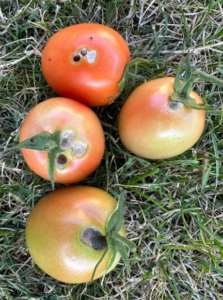Finding holes in your tomatoes can be disappointing and frustrating, especially after carefully nurturing your plants. But don’t rush to discard your precious produce! In this article, you’ll learn exactly why holes appear in tomatoes, how to determine their safety, and practical ways to reduce waste by salvaging your harvest.
Why Do Holes Appear in Tomatoes?
Tomatoes can develop holes due to several reasons. The most common include:
- Insects and Pests: Tomato worms, beetles, and other pests often pierce tomato skins, causing visible damage.
- Birds or Wildlife: Birds or wildlife may occasionally bite or peck tomatoes, leaving noticeable puncture marks.
- Physical Damage: Handling, weather events, or garden tools can accidentally damage the tomato’s skin.
Are Tomatoes with Holes Safe to Eat?
Most tomatoes with small holes remain perfectly safe to consume. Follow these simple guidelines:
 Safe to Eat: If the tomato’s interior is fresh, without mold, rot, or foul odors, simply cut away the affected area.
Safe to Eat: If the tomato’s interior is fresh, without mold, rot, or foul odors, simply cut away the affected area.
 Discard Immediately If:
Discard Immediately If:
- Dark spots surround the hole
- Mold is visible
- There’s an unpleasant odor

Practical Tips to Reduce Waste with Damaged Tomatoes
1. Cut and Use the Healthy Parts
- Remove the damaged section with a clean knife.
- Use the remaining tomato in salads, sauces, or soups.
2. Compost or Garden Fertilizer
If your tomato is heavily damaged or moldy, use it in your compost pile to enrich your garden soil naturally.
3. Save the Seeds
Extract and dry seeds from healthy tomatoes to grow your own organic tomato plants next season.
Preventive Measures to Avoid Holes in Tomatoes
- Regularly inspect plants for pests and remove them immediately.
- Provide proper spacing, watering, and nutrients to ensure healthier plants.
- Use natural pest deterrents or beneficial insects, like ladybugs, to protect your crops.
Final Thoughts: Don’t Waste Your Tomatoes!
By examining your tomatoes carefully, you can significantly reduce waste, save money, and enjoy more of your homegrown produce. Remember—minor imperfections often don’t affect taste or safety, and taking steps to manage pests naturally can protect future harvests.













